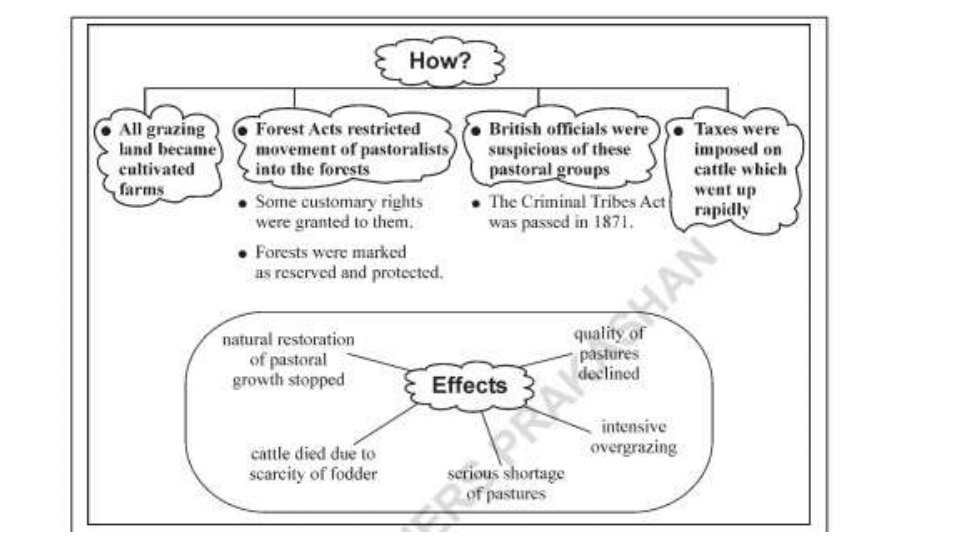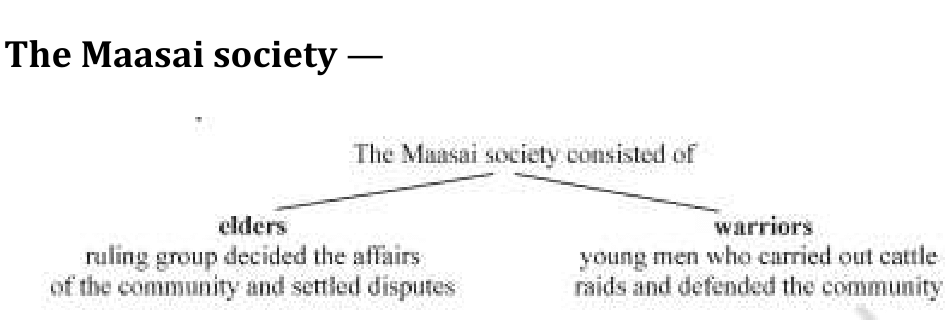Class 9 Exam > Class 9 Notes > Chapter – 5 History Pastoralists in the Modern World
Chapter – 5 History Pastoralists in the Modern World - Class 9 PDF Download
NOMADISM AS A WAY OF LIFE
The Mountain Nomads
• The Gujjar Bakarwals of Jammu and Kashmir — They are pastoral nomads who move in
groups called ‘Kafila’. Their movements are governed by the cold and snow. In winters
when the high mountains are covered with snow these Gujjars move down to the low hills
of the Sivalik range. On the onset of summer, when the snow melts and the mountains
become lush and green, these pastoralists move back to the mountains.
• The Gaddi Shepherds of Himachal Pradesh have a similar cycle of movement. They also
spend the winter on the low Sivalik hills and the summers in Lahul and Spiti.
• The Gujjar cattle herders of Kumaon and Garhwal spend their summers in the ‘bugyals’
and their winters in the ‘bhabar’.
• The Bhotias, Sherpas and Kinnauri follow the cyclic movement which helps them to adjust
to seasonal changes and make best use of pastures.
On the plateaus, plains and deserts —
• The Dhangars of Maharashtra: The Dhangars stay in the central plateau of Maharashtra
during the monsoon. This is a semi-arid region. By October they begin their movement
towards Konkan. Here their cattle help to manure the fields and hence they are welcomed
by the Konkani peasant. As soon as the monsoon sets in, they retreat back to the semi-arid
land of Maharashtra.
• The Gollas who herd cattle and the Kurumas and Kurubas who reared sheep and goat are
from Karnataka and Andhra. They live near the woods and in the dry periods they move to
the coastal tracts.
• The Banjaras of Uttar Pradesh, Punjab, Rajasthan, Madhya Pradesh and Maharashtra
move to different places in search of good pastures.
• The Raikas of Rajasthan combine cultivation with pastoralism. When their grazing
grounds become dry they move to new and greener pastures.
• Pastoral life was sustained by
• their sense of judgement to know how long one must stay in an area
• to know where they could find food and water
• to assess and calculate the timings of their movement
• their ability to set up a relationship with the farmers so that the herds could graze on the
harvested fields.
CHANGES IN PASTORAL LIFE DUE TO COLONIAL RULE
• Under colonial rule the life of the pastoralists changed completely. Their grazing grounds
became less, their movements were regulated, the revenues they had to pay increased,
their trade and crafts and agricultural produce declined.

Coping with changes —
• Some reduced the number of cattle in their herds.
• Some discovered new pastures.
• Some bought land and began to lead a settled life.
• Some poor peasants borrowed money to survive, in due course of time they lost their
cattle and sheep and became labourers.
PASTORALISM IN AFRICA
The Maasai — Changes in their way of life
The Maasai cattle herders live primarily in East Africa. Rules, laws and regulations have changed their way of life. There are many problems which they have faced, the most prominent being
continuous loss of their grazing grounds. This has many reasons:

• scramble for territorial possessions in Africa.
• dividing the region into different colonies.
• best grazing grounds being taken over by the white settlements.
• grazing grounds being converted to cultivated land and national parks and game reserves.
The Kaokoland herders have faced a similar fate.
Confined to special reserves — Traditionally, pastoralists moved to different pastures but with
the restrictions imposed on them these pastoralists were confined to special reserves. They could
not move without special permits. They were not allowed to enter the markets in white areas.
Some tribes were affected by the Criminal Tribes Act. Even their trade activities were adversely
affected.
Why nomadism — Pastoralists are nomadic — this allows them to survive bad times and avoid
crises, such as drought. But later they could not shift to greener pastures and their cattle died of
starvation.
The Maasai society —
The British appointed chiefs to administer the affairs of the tribe. These chiefs were wealthy and
lived a settled life as they had both pastoral and non-pastoral income. The poor pastoralists
passed through bad times and worked as labourers. There were two important changes :
• the traditional difference between the elders and warriors was disturbed.
• there came to be a marked difference between the rich and poor.
Developments within Pastoral Societies
Pastoralists adapt to new times. They find new pastures, change their routes for their annual
movement, reduce their cattle numbers, press for their rights, etc. It is being advocated today
that pastoral nomadism is the best form of life suited to the dry, semi-arid and mountainous
regions of the world.
FAQs on Chapter – 5 History Pastoralists in the Modern World - Class 9
| 1. What is the significance of pastoralists in the modern world? |  |
Ans. Pastoralists play a significant role in the modern world as they continue to practice traditional livestock rearing and contribute to the global economy through the production of dairy products, meat, and wool. They also play an important role in preserving biodiversity and maintaining a balance in the ecosystem.
| 2. How have pastoralists adapted to the challenges of the modern world? |  |
Ans. Pastoralists have adapted to the challenges of the modern world by incorporating modern technologies and practices into their traditional way of life. They have adopted modern modes of transportation for livestock movement, used improved breeding techniques to enhance livestock productivity, and diversified their income sources by engaging in activities such as tourism and handicrafts.
| 3. What are some of the main issues faced by pastoralists in the modern world? |  |
Ans. Pastoralists face several challenges in the modern world, including land encroachment by other economic activities, competition for resources, climate change, and government policies that often neglect their needs. These issues can lead to conflicts, loss of traditional grazing lands, and the disruption of their way of life.
| 4. How do pastoralists contribute to the preservation of traditional knowledge and cultural heritage? |  |
Ans. Pastoralists are custodians of traditional knowledge and cultural heritage related to livestock rearing, herding practices, and the sustainable use of natural resources. They pass down this knowledge from one generation to another through oral traditions and practical experience, ensuring the preservation of unique cultural practices, rituals, and social systems associated with pastoralism.
| 5. What are the economic opportunities for pastoralists in the modern world? |  |
Ans. In the modern world, pastoralists have various economic opportunities. They can engage in the production and sale of high-quality dairy products, meat, and wool to meet the growing demand in urban areas. Additionally, they can participate in eco-tourism initiatives by offering cultural experiences and showcasing their traditional way of life to tourists. They can also generate income through the production and sale of handicrafts made from animal by-products.
Related Searches



















